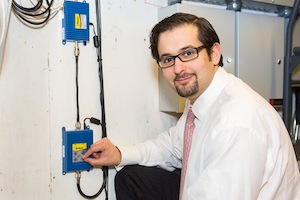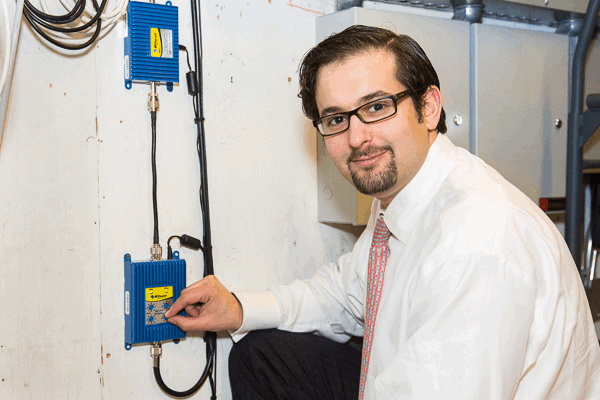
A passive distributed antennae system (DAS), more commonly known as a cell phone signal booster system, by Wilson Electronics was installed by CK Technology Group, led by Brad Peskin, director of operations.
The New York City headquarters of SCN’s parent company, NewBay Media, recently demonstrated a value-add sales opportunity for integrators dealing with the challenges presented by today’s increasingly mobile world.
A passive distributed antennae system (DAS), more commonly known as a cell phone signal booster system, was installed by CK Technology Group, led by Brad Peskin, director of operations.
NewBay Media’s office in Manhattan is subject to all of the RF challenges and hyper-saturation of devices that densely populated urban environments present, and thus was an ideal case study for installation of a DAS. Employees have long complained about the near complete lack of cell phone reception in the building, challenging business calls to company-issued cell phones and rendering data usage of smartphone apps and other tools ineffective.
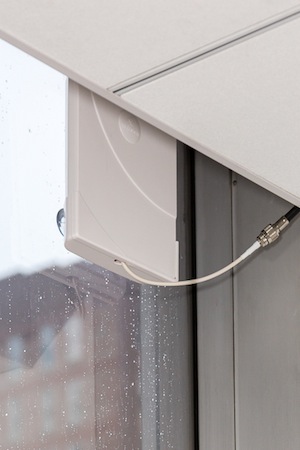
Rooftops are prime real estate in Manhattan, and placing the feeder antenna there for NewBay’s install would likely have involved additional permits, insurance, damage waivers, and as a result, significant delays in the project. For this reason, an internally mounted feeder was selected.
As AV integrators and IT professionals alike increasingly field complaints on projects with ineffective cellular distribution—due in part to increased dependence on mobile devices—signal boosters are a natural addition to the technologies they provide. Wilson Electronics manufactures these systems specifically “designed to be installed by most technicians already operating in the AV and structured cabling marketplace,” Peskin noted. “Similar skillsets are employed to install and tune these high-performance systems as are in high-end, cutting-edge AV and communication network applications. Integrators will enjoy an additional revenue stream easily tapped during a cabling or design project for other systems while AV tech managers and system administrators will benefit from a high-performance space equipped to communicate with the outside world readily and more reliably than ever before.”
NewBay’s installation followed much of the same process CK Technology Group uses for other passive DAS projects, along with some unique situations and challenges, which typically vary per job.
After conducting an initial site survey to determine where signal coverage was needed and for which cell carriers, Peskin, a trained RF tech, measured signals outside the NewBay building using an advanced signal reader to determine the best place to install the “feeder” antenna. The feeder antenna brings the outside signal inside, and distributes it throughout the designated area, focusing on the most important coverage areas. Usually, the feeder antenna is ideally placed on the roof of the building, but this can present a number of potential issues, including dealing with permission from a landlord. Rooftops are prime real estate in Manhattan, and placing the feeder antenna there for NewBay’s install would likely have involved additional permits, insurance, damage waivers, and as a result, significant delays in the project. For this reason, an internally mounted feeder was selected.
NewBay’s various print and web brands are housed on separate floors, three floors apart and on opposite sides of the building, presenting another challenge for CK Technology Group because the system requires ample separation between the feeder and distribution antennas. “If there is not sufficient distance between these antenna systems, oscillation will likely occur, and the system will cease to function correctly,” Peskin explained. “The way we got around this likely scenario at NewBay, was to put the external antenna for the 12th floor system on the ninth floor and the external antenna for the ninth floor system on the 12th floor. We found windows in the corners of each floor with adequate available signal and used window-mount antennas to feed the system for both floors.”
This was the most pressing issue the CK crew had to deal with on the project. Their novel solution “was by no means fool-proof,” Peskin contended, adding that it was “something relatively untested in the field, though theoretically, it [would] work fine.”
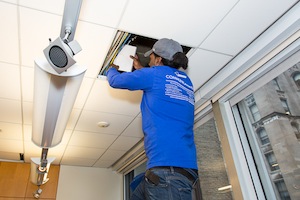
Gordon Barran was one of the network technicians for CK Technology Group responsible for wiring and connecting the internal and external antennas to the boosters, amplifiers, and other components making up the system.
The team turned to Wilson’s engineering support staff for a second opinion, which confirmed CK’s solution. Wilson’s customer support is very active and available to help integrators with design configurations and solutions, and they proactively double check plans that installers develop. Peskin identified the “stellar engineering support enjoyed by installers” as a “huge benefit of installing Wilson products.”
The next step in the install was to wire and connect the internal and external antennas to the boosters, amplifiers, and other components making up the system. Then the team conducted a “soft power-on,” running the system before everything is permanently bolted in place. “This [allowed] us the flexibility to adjust location and positioning of key elements before making more permanent equipment installations,” Peskin said.
Once the components were firmly in place, NewBay’s IT director, Anthony Verbanac monitored the system and facilitated feedback from employees to determine what subsequent fine-tuning was required. It is common for CK to conduct tuning over two to four weeks in a challenging RF environment, and Peskin’s team did have to do so in NewBay’s case.
The tuning also allowed CK Technology Group to make subsequent adjustments to the system. “In the end, after two or three times of tuning and re-tuning, we got the separation calculations just right, and the system functioning very well. On our third and final time back at NewBay for a tune, we did happen to notice that a server room on the 12th floor had a ‘sweet spot’ for signal, so to add some redundancy and further reliability to the system, we installed a third feeder antenna via a magnetic mount in the server room, as well as additional inline boosters on this floor.”
Verbanac has observed various benefits the system has provided. “After the final tuning of the system it appears to be working great. I am able to take calls on my cell phone; they are clear with no drops, and I get voicemail notifications and SMS text messages. Also, battery life is noticeably longer since the phone isn’t constantly searching for a signal. Before the system was in place, cell phones were basically useless while in the office.”
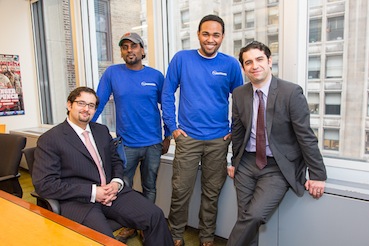
Installer team, from left to right: Bradley Peskin, Director of Operations, Gordon Barran, Network Technician, Bernard Barran, Network Technician, Chris Kossifos, Managing Director.
He also praised the installation team. “Brad Peskin came in, listened to our complaints, took the necessary signal readings, and designed a system that would work best in our unique environment. The installation team was courteous and dedicated and made sure not to disrupt any employees while wiring for two floors.”
Peskin said he chooses to use Wilson’s boosters over others in the market because of they have “proven to be robust, reliable, and most importantly, relatively easily deployed and affordable.”
The modular nature of Wilson’s products also makes system modifications less expensive and quicker. It’s also important to note that some of the other solutions on the market are not FCC compliant and may interfere with broadcast signals.
